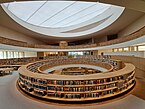Modern Jewish historiography
Modern Jewish historiography is the scholarly analysis of
Background and context
Jewish people had a long tradition of historical writing prior to their encounters with the Hellenistic world.
The major publications in Jewish history in the early modern period were influenced by the political climate of their respective times.[6][7][8][9][10] Certain Jewish historians, acting on a desire to achieve Jewish equality, used Jewish history as a tool towards Jewish emancipation and religious reform. "Envisaging Jewish identity as essentially religious, they created a Jewish past that focused on Jewish religious rationality, and stressed Jewish integration within the societies in which Jews lived."[11]

Attitudes toward historical writing
Talmudic authorities discouraged the writing of history in the medieval and early modern era; the extent to which this was effective in discouraging actual historical production is unclear.

Bonfil surmises that the return to traditionalism in orthodoxy was actually a later phenomenon, a reactionary response to modernity.[18] When those among the halakhic authorities who valued philosophy studied it, such as Moses Isserles, they justified it with a continuity to Hellenistic philosophy.[28][29]
Notably,

Medieval sources
About 90% of world Jewry inhabited the Muslim world around the Mediterranean in the medieval period.
Over 400,000 manuscript fragments in the
Iggeret of Rabbi Sherira Gaon (987)[47][48][49] and Sefer ha-Qabbalah (1161)[50] by Abraham ibn Daud (ibn David)[51] were two medieval sources available to and trusted by Jewish early modern historians.[52][53][54] Ibn David is considered one of the first rationalist Spanish Jewish philosophers.[55] The 10th century responsa of the Geonim are an important corpus of correspondence. Iraqi Jews in areas such as Baghdad and Basra, were an important community in this time period and corresponded with the Talmudic academies in Babylonia.[56]

Josippon
The work emerged from the context of

Josippon was also a popular work or a
Jewish expulsions and the Spanish Inquisition
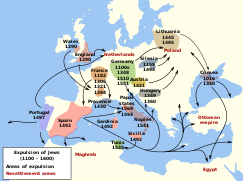
Jewish expulsions accelerated in the 15th century and influenced the growth in Jewish historiography.[85][34] Sephardic Jews from Spain, Portugal, and France settled in Italy and the Ottoman Empire during this period, shifting the nexus of Jewry east.[86] The Languedoc region, which had a large population and respected rabbis known collectively as the Hachmei Provence, were forced to convert or flee in the 14th century, and they sought to avoid detection, which creates a paucity of documentation and a difficult scenario for historians.[87] Within Italy, there was also considerable upheaval with the migration and expulsion of Jews in the Papal States in the late 1500s.[88]
The Spanish Inquisition attempted to burn any parchment or paper containing Hebrew, and any book known to have been translated from Hebrew. This led to an estimated millions of texts destroyed in Spain and Portugal, especially centers of academic learning as Salamanca and Coimbra, rendering surviving manuscripts in foreign libraries rare and hard to come by.[89]
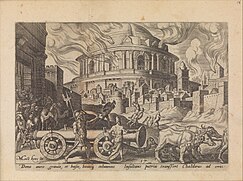
Whether the Spanish Inquisition's records are truthful or worthy of trust is the subject of debate. Historians such as Yitzhak Baer and Haim Beinart have taken the view that the crypto-Jews were sincerely Jewish; Benzion Netanyahu has argued they were sincerely Christian converts, and their secret practice of Judaism a myth, before changing his view; Norman Roth has also argued the Inquisition's records can be trusted, which is disputed.[90]
Early modern histories in the post-medieval and Renaissance era
The 16th century is considered something of a blossoming of Jewish historiography by some historians, such as Yerushalmi, who characterizes the focus as shifting social and post-biblical.[63][22] Although some historians focus on the 19th century as an important period in the development of modern Jewish historiography, the 16th century is also considered an important period.[91] Religion figured prominently and the differences in martyrdom and messianic figures in Sephardic and Askenazic communities post-expulsion are the subject of historiographical debate.[92] Some historians, such as Bonfil, have disagreed with Yerushalmi that this period produced a significant sea change in historiography.[93][14]

The Book of the Honeycomb's Flow (1476) by Italian rabbi Judah Messer Leon (c.1420-1498) (Judah ben Jehiel, alias Leone di Vitale) is an early work of humanistic classical rhetorical analysis that was also noted by Graetz, which was noted by Bonfil, and paraphrasing Israel Zinberg stated, he "was a child not only of the old people of Israel, but also of the youthful Renaissance." Nofet Zufim drew on the classical theoretical writings of Cicero, Averroes and Quintilian[94] While not a work of history, it was a precursor to Azariah dei Rossi and cited by him as opening the door to the value of secular studies. It was printed by Abraham Conat.[95] David ben Judah Messer Leon, his son, published a humanistic work defending the literary arts in Constantinople in 1497.[96]
The 1504 historic work of the Portuguese royal astronomer[97] Abraham Zacuto (1452-1515),[98][99] Sefer ha-Yuḥasin (Book of the Genealogies), contains anti-Christian historiographical polemic and urging of strength in the face of persecution and Jewish martyrdom.[100] Still, Zacuto was aware of and depended on secular work.[4] Zacuto was an important scientist who befriended Columbus and provided a meaningful new astrolabe for the Portuguese explorers in addition to his work in history and commentary. Abraham A. Neuman writes,
Sefer Yuhasin is a medley of historical biographical notes, reminiscences, comments and observations which often express his inner thoughts. Here, he appears in his strength and weakness, a man of numerous contradictions. He was necessarily a many-sided figure, for he lived and participated in the adventures of an explosive age, midway between medievalism and modernism, holding in its grasp the Inquisition and the discovery of new worlds.[101]

It is primarily a world history with specific attention to the Jewish plight, from creation to 1500.[102] Sefer Yuhasin traces the chronology and development of the Oral Torah, and contains critical appraisal of Talmudic evidence. Zacuto expresses his view of the importance of familiarity with Roman history. He was familiar with Josippon but was apparently unfamiliar with the genuine Josephus; Samuel Shullam, his editor who published his annotated version in 1566, was familiar with the original Josephus, and inserted comments and glosses with corrections.[103]
Italian talmudic chronologer Gedaliah ibn Yahya ben Joseph's (1515-1587) 1587 Shalshelet ha-Kabbalah (Chain of Tradition) was also of significance during this period.[104][63] It included a justification of Aristotelian and Neoplatonic philosophy.[105] The "chain of tradition" or the successor tradition is also used to refer to the continuation aspect of historians building on the shared reference base of works by creating introductions or citations to prior work, key to rabbinic textual analysis in the mishnah or mesorah well as Jewish historiography.[85][106] Italian Jewry in particular benefitted from factors such as education, geography, and access to printing. They enjoyed relative freedom during the period and had contact with Christian scholars. Besides their interest in Jewish text, they also pursued the sciences, medicine, music, and history.[107] The liberal dukes of d'Este practiced toleration of Jewish faith.[108]
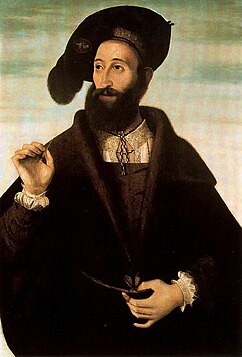
ibn Verga
Solomon ibn Verga (1460-1554)'s 1520 Scepter of Judah (Shevret Yehudah) was a notable chronicle of Jewish persecutions, written in Italy and published in the Ottoman Empire in 1550.[21][109][110][111][112][113][114] It contains some 75 stories of Jewish persecution,[115] and is a transitional work between the medieval and modern periods of Jewish history.[116][117] Born in Spain, Verga's views were shaped by the expulsion in 1492, his forced baptism, and the massacres as he fled Portugal.[115][118] Shevret Yehudah was "the first Jewish work whose main concern was the struggle against ritual murder accusations."[116] It was cited by his contemporary Samuel Usque, Consolação às Tribulações de Israel ("Consolation for the Tribulations of Israel"), Ferrara, 1553.[119][120][121] Usque was a trader.[122] Rebecca Rist has called it a satirical work that blends fiction with history.[123] Jeremy Cohen has said Verga was a pragmatist who presented benevolent and enlightened characters with a happy ending.[124][125][126]
ha-Cohen
dei Rossi
Azariah dei Rossi (1511-1578) was an Italian-Jewish physician, rabbi, and a leading Torah scholar during the Italian Renaissance. Born in Mantua, he translated classical works such as Aristotle, and was known to quote Roman and Greek writers along with Hebrew in his work.[140][141][142] He is often considered the father of modern Jewish historiography.[143] He was the first major author in Jewish historiography to incorporate and edit non-Jewish texts into his work.[91] His 1573 work Me'or Einayim (Light of the Eyes) is an important early work of humanistic 16th century Jewish historiography.[144][63][145][22][146] It includes a polemic critique of Philo noted by Baron and Norman Bentwich; Philo's work was popular among contemporary Italian Jews.[58] Rossi drew on the Latin Josephus, with specific annotations on source text versions for the Jewish academies at Ferrara, and investigated the Septuagint.[103] Bonfil writes that it was an attempt at a "New History" of the Jews and a work of ecclesiastical historiography, that adopted as its main tool, logical and philological criticism.[18] Rossi also cited rabbinical material and Jewish writers such as Zacuto; Baron has also noted it was an apologetic work, and Bonfil has asserted ultimately a conservative work with a medieval worldview, but nonetheless pioneering in its critical study and methods.[147]
De Rossi's work was critical of the rabbinical establishment, questioning the historicity of post-biblical Jewish legends, and was met with condemnation, opprobrium and bans; Joseph Caro called for it to be burned, though he died before this was carried out, and

Rossi went to
Despite its controversial status, Rossi's work was known in the 17th and 18th centuries, per
Gans
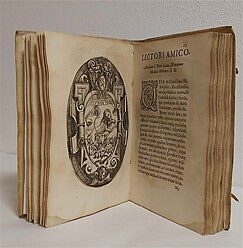
17th century
Hannover
Nathan ben Moses Hannover's Yeven Mezulah (Abyss of Despair) (1653)[169][170][171][172] is a chronicle of the Khmelnytsky massacres or pogroms in eastern Europe in the mid 17th century. While a massacre certainly occurred, accounts and casualty numbers differ among Ukrainian, Polish, and Jewish historians.[173][174] All three groups also use the story as part of their own national ideologies.[175]
Basnage
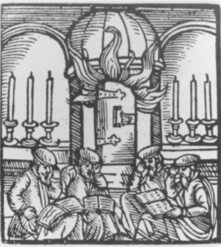
It was said to be the first comprehensive post-biblical history of Judaism and became the authoritative work for 100 years;[178] Basnage was aware that no such work had ever been published before.[179] Basnage sought to provide an objective account of the history of Judaism.[180][181] His work was widely influential, and developed further by other authors such as Hannah Adams.[182][183] Basnage's work is considered the birth of the "Christian historiography" of Jewish history.[130]
18th century
In the 18th century, reformists such as
According to
The Haskalah made education a priority and produced pedagogical literature in the humanistic vein, such as that of Satanow and David Friedländer.[196] The Haskalah became interested in Sephardic Jewish sources and had an idea of historiography with an eye toward reformism.[197][198] The scholarship of the Sephardim held a mystique for emancipated German Jews who had an opportunity to redefine their identities.[199] They held manuscripts in held esteem, and superior to other types of sources.[3]
The travel diary of Chaim Yosef David Azulai (1724-1806) is one important source for information on the broader Jewish world during this period.[200][201] The Vilna Gaon was another figure that encouraged critical reading of text and scientific study during this period.[202]

There was also significant progression in Yiddish historiography during the 18th century such as the work of Menahem Amelander (also called Menahem ben Solomon ha-Levi or Menahem Mann) in the Netherlands, who translated Josippon.[91][204][205][206][207][66][208] He also drew on Basnage.[209] His 1743 work Sheyris Yisroel (Remnant of Israel) picks up where Josippon left off.[205] It is a continuation of his Yiddish translation of Josippon with a general history of the Jews in the diaspora until 1740.[204] Max Erik and Israel Zinberg considered it the foremost representative of its genre.[210] It was cited by Abraham Trebitsch with his Qorot ha-'Ittim and Abraham Chaim Braatbard with his Ayn Naye Kornayk.[85] Zinberg called it "the most important work of Old Yiddish historiographical literature".[211]
The Lithuanian rabbi Jehiel ben Solomon Heilprin (1660-1746)'s Seder HaDoroth (1768) was another 18th century historical work which cited the earlier work by Gans, ibn Yahya and Zacuto as well as other medieval work such as the itinerary of Benjamin of Tudela.[212][213]
19th century and birth of modern Jewish studies
Yosef Hayim Yerushalmi wrote that first modern professional Jewish historians appeared in the early 19th century,[214] writing that "[v]irtually all nineteenth-century Jewish ideologies, from Reform to Zionism, would feel a need to appeal to history for validation".[215] He has further explained that the 19th century themes of martyrology and the chain of rabbinic tradition were a line of continuation from the medieval era; Daniel Frank has suggested a corollary, that Jewish history had tended to focus on these themes and ignore threads without clear expression of them.[216]

The German
Another important father of the movement was
David Cassel was a notable historian and student of Zunz.[221] Edouard Gans was one of Hegel's students.[222]
Abraham Geiger founded the Hochschule für die Wissenschaft des Judentums or school/seminary for Jewish studies, in Berlin in 1872, which remained until it was shuttered by the Nazis in 1942.[223]
Solomon Schechter was an important Moldavian-born, later British-American rabbi. A student of the Hochschule, he went on to start his own American school, become president of synagogues and was influential in the development of Conservative Judaism in the United States. He was also influential in British and American Jewish education. Schechter became aware of the Cairo Geniza and was instrumental in bringing the documents to Cambridge University Library and the Jewish Theological Seminary for study.[224][225]

The Wissenschaft has been called "institutionalized German historicism," and a number of historians from Funkenstein to Meyer to Shmuel Feiner and Louise Hecht have challenged Yerushalmi's interpretation that the 19th century narrative is the salient shift in the characterization of Jewish historiography into modernity.[203]
Significant work from the 19th century included Moritz Steinschneider (1816-1907)'s Geschichtsliteratur der Juden.[227][228][229] Steinschneider became the preeminent scholar of the period.[219] The work of Julius Fürst was also significant.[226][230]
Théodore Reinach (1860-1928)'s Histoire des Israelites (1884) is the most significant example of 19th-century French-Jewish historiography which is something of a counterpoint to the mainstream German development in this time.[231] Marco Mortara (1815-1894) can be considered an Italian-Jewish version.[232] Isidore Loeb (1839-1892) founded the Revue des Études Juives or Jewish studies review, in 1880 in Paris. British Jews Claude Montefiore and Israel Abrahams founded The Jewish Quarterly Review, an English counterpart, in 1889.[233] Emmanuel Levinas, a Lithuanian-French philosopher, offered a "new science of Judaism" critique of the Wissenschaft pertaining to Jewish particularism.[234]

Forerunners to Jewish national Zionist historiography from the 19th century include
Jost
Isaak Markus Jost (1793-1860) was the first Jewish author to publish a comprehensive post-biblical modern history of the Jews.[236] His Geschichte der Israeliten seit den Zeit der Maccabaer, in 9 volumes (1820–1829), was the first comprehensive history of Judaism from Biblical to modern times by a Jewish author. It primarily focused on recounting the history of the Jewish religion.[237]
Jost's history left "the differences among various phases of the Jewish past clearly apparent". He was criticized for this by later scholars such as Graetz, who worked to create an unbroken narrative.[238]
Unlike Zunz, Jost has an anti-rabbinical stance, and sought to free Jewish history from Christian theology. He saw influence from Greco-Roman law and philosophy in Jewish philosophy, and sought to secularize Jewish history.[239]
Zunz
Leopold Zunz (1794-1886), a colleague of Jost, was considered the father of academic Jewish studies in universities, or Wissenschaft des Judentums (or the "science of Judaism").[240] Zunz' article Etwas über die rabbinische Litteratur ("On Rabbinical Literature"), published in 1818, was a manifesto for modern Jewish scholarship.[150] Zunz was influenced by Rossi's philological and comparative linguistics approach.[202] Though they were childhood friends, Zunz had a harsh and perhaps jealous criticism of Jost's earlier work and sought to improve on it.[241] Zunz was a student of August Böckh and Friedrich August Wolf and they influenced his work.[150]
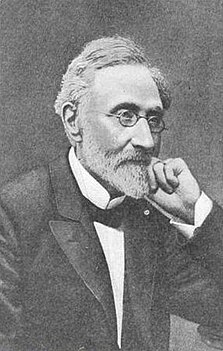
Zunz urged his contemporaries to, through the embrace of study of a wide swath of literature, grasp the geist or "spirit" of the Jewish people.[242] Zunz proposed an ambitious Jewish historiography and further proposed that Jewish people adopt history as a way of life.[150] Zunz not only proposed a university vision of Jewish studies, but believed Jewish history to be an inseparable part of human culture.[243] Zunz's historiographical view aligns with the "lachrymose" view of Jewish history of persecution.[244] Zunz was the least philosophically inclined of the Wissenschaft but the most devoted to scholarship.[245] Zunz called for an "emanicipation" of Jewish scholarship "from the theologians."[246] He was the editor of Nachman Krochmal.[247]
Contrasting with earlier bible printing, Zunz adopted a re-Hebraization of names.[248]
Zunz was politically active and was elected to office. He believed that Jewish emancipation would come out of universal human rights.[249] The revolutionary year of 1848 had an influence on Zunz, and he expressed a messianic eagerness in the ideals of equality.[250] Zunz's stated goal was to transform Prussia into a democratic republic.[251]
Graetz
Heinrich Graetz (1817-1891) was one of the first modern historians to write a comprehensive history of the Jewish people from a specifically Jewish perspective.[252][253] Geschichte der Juden (History of the Jews) (1853-1876) had a dual focus. While he provided a comprehensive history of the Jewish religion, he also highlighted the emergence of a Jewish national identity and the role of Jews in modern nation-states.[254][255] Graetz sought to improve on Jost's work, which he disdained for lacking warmth and passion.[256]
Salo Baron later identified Graetz with the "lachrymose conception" of Jewish history which he sought to critique.[257]

20th century histories
The 20th century saw the

Ephraim Deinard (1846–1930) was a notable 20th century historian of American Jews.[261] The writings of Gershom Scholem and Hannah Arendt are also important in modern Jewish historiography of the 1940s.[262][263][264][265] Scholem was a critic of the Wissenschaft for their history that had omitted Jewish mysticism.[266] Martin Buber also was a significant exponent of Jewish mysticism building on the work of Scholem in the 20th century.[2]
While most of the historians associated with the Wissenschaft were men, Selma Stern (1890-1981) was the first woman associated with the movement and one of the first professional female historians in Germany.[267]
Dubnow

Simon Dubnow (1860-1941) wrote Weltgeschichte des Jüdischen Volkes (World History of the Jewish People), which focused on the history of Jewish communities across the world. His scholarship developed a unified Jewish national narrative, especially in the context of the Russian Revolution and Zionism.[268] Dubnow's work nationalized and secularized Jewish history, whilst also moving its modern center of gravity from Germany to Eastern Europe and shifting its focus from intellectual history to social history.[269] Michael Brenner commented that Yerushalmi's "faith of fallen Jews" observation "is probably applicable to no one more than to Dubnow, who claimed to be praying in the temple of history that he himself erected."[270]
Dinur
Ben-Zion Dinur (1884 – 1973) followed Dubnow with a Zionist version of Jewish history. Conforti writes that Dinur "provided Jewish historiography with a clear Zionist-nationalist structure... [and] established the Palestine-centric approach, which viewed the entire Jewish past through the prism of Eretz Israel".[271]
Dinur was the first Zionist scholar to study the fate of Jewish communities in Palestine during the Crusades.[272]
Baron

Baron's work further developed the Jewish national history, particularly in the wake of the Holocaust and the establishment of Israel.

Baron admired and even revered Graetz, who was an influence on him, but he sought to counter and critique the historical view espoused by the older historian.[285] Engel says the Baronian view of history stresses continuities, rather than ruptures.[257] Baron's analysis of Jewish historiography runs through Zacuto, Hacohen, Ibn Verga, to Jost, Graetz, and Dubnow.[286] Baron believed older work to be "parochial."[287] Adam Teller says his work is an alternative to history motivated by persecution and antisemitism, at the risk of de-emphasizing the impact of violence on Jewish history.[257] Esther Benbassa is another critic of the lachrymose conception and says that Baron is joined by Cecil Roth and to a lesser extent Schorsch in restoring a less tragic vision of Jewish fate.[288][289]
Baer
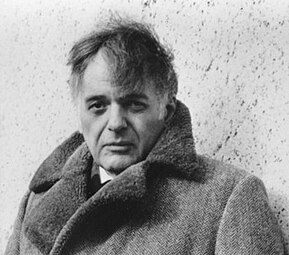
Later 20th century: history of historiography
Jewish historiography also developed uniquely in
Beginning around 1970, a new Polish-Jewish historiography gradually arose, driven by reprints of works by Zinberg, Dubnow, and Baron, as well as new consideration by
The concept of
Yerushalmi

Yosef Hayim Yerushalmi (1932-2009) wrote Zakhor: Jewish History and Jewish Memory (1982) which explored the intersection of historical scholarship and Jewish collective memory, including mythology, religion and assimilation. The term Zakhor is an imperative "Remember," and the book discusses the author's perception of the decay in memory and the impact on the Jewish psyche; his core belief is that one can never stop being Jewish.[303][304] It has been described as the "pathbreaking study on the relationship between Jewish historiography and memory from the biblical period to the modern age".[305]
Yerushalmi's work can be viewed largely as critique of the Wissenschaft.[306] He was influenced by his teacher, Salo Baron, whose classes he attended at Columbia University where he later taught, and saw himself as a social historian of Jews, not of Judaism.[307] Yerushalmi was born and lived most of his life in New York City, aside from a stint at Harvard University in Cambridge, Massachusetts.[23] Whilst Yerushalmi's work largely centered on premodern Jewish histories, it set the stage for future analysis of modern Jewish histories, per his student Brenner.[308] Yerushalmi deeply studied the Sephardim, such as Isaac Cardoso, particularly the marrano or converso, i.e. crypto-Jewish or forced Catholic secular Jews, which were a core historical interest.[34][309] In addition to his work on the Sephardim, Yerushalmi's history also focused on German Jewish, not Eastern European Jewish social history, despite being American Eastern European Jewish himself.[310] Yerushalmi wrote that:
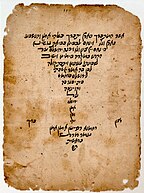
...the secularization of Jewish history is a break with the past, [and] the historicizing of Judaism itself has been an equally significant departure... Only in the modern era do we really find, for the first time, a Jewish historiography divorced from Jewish collective memory and, in crucial respects, thoroughly at odds with it. To a large extent, of course, this reflects a universal and ever-growing modern dichotomy... Intrinsically, modern Jewish historiography cannot replace an eroded group memory which, as we have seen throughout, never depended on historians in the first place. The collective memories of the Jewish people were a function of the shared faith, cohesiveness, and will of the group itself, transmitting and recreating its past through an entire complex of interlocking social and religious institutions that functioned organically to achieve this. The decline of Jewish collective memory in modern times is only a symptom of the unraveling of that common network of belief and praxis through whose mechanisms, some of which we have examined, the past was once made present. Therein lies the root of the malady. Ultimately Jewish memory cannot be "healed" unless the group itself finds healing, unless its wholeness is restored or rejuvenated. But for the wounds inflicted upon Jewish life by the disintegrative blows of the last two hundred years the historian seems at best a pathologist, hardly a physician.[311]

Some scholars such as Bonfil, Yerushalmi's students David N. Myers and Marina Rustow, and Amos Funkenstein took issue with Yerushalmi's interpretation of the importance of Jewish historiography or its relative abundance in the medieval period. In particular, Funkenstein argues that collective memory is an earlier form of historical consciousness, not a fundamental break.[21][312][113] Rustow says that Yerushalmi's core thesis rests on a narrow definition of historiography and explores the issue of historical particularism.[313] Gavriel D. Rosenfeld writes that Yerushalmi's fear that history would overtake memory was unfounded.[314] Myers writes that his teacher took the criticism of his paper, which contextualized the work as a post-Shoah malaise and a postmodern authorial perspective, hard, and did not know how to respond to it, leading to estrangement that lasted years before reconnecting shortly before his professor's death.[23]
Yerushalmi is also described by Rustow as practicing microhistory, that he did not believe in traditional methods, "heritage", "contributions", but sought a spirituality and "immanence" in his study of history.[34] Yerushalmi was frustrated by "antiquarianism" and the anachronistic view of history. He had a complex relationship with the Jerusalem school of historians including Baer, whom he disagreed with, but was influenced by, and Scholem. He was also influenced by Lucien Febvre. Rustow, writes that Yerushalmi, like his teacher Baron, believed modernity to be a trade-off and that the role of the Church in protecting, as well as persecuting, the Jewish people of premodern Europe was "anti-lachrymose," and drew admiration from his teacher. However she writes that he agreed with Baer and Scholem that history could be only understood in Jewish terms, and disagreed with Baron's more integrationist view. Ultimately, he is criticized for accepting the sources of the Spanish Inquisition without characterizing their motive as anti-Jewish.[34] One of Yerushalmi's major themes as expressed in the foreword to Zakhor is about a proposed return to previous modes of thinking.[315]

Meyer
Michael A. Meyer's Ideas of Jewish History (1974) is a milestone in the study of modern Jewish histories, and Meyer's ideas were developed further by Ismar Schorsch's "From Text to Context" (1994). These works emphasized the transformation of Jewish historical understanding in the modern era and are significant in summarizing the evolution of modern Jewish histories. According to Michael Brenner, these works – like Yerushalmi's before them – underlined the "break between a traditional Jewish understanding of history and its modern transformation".[316]
Brenner

Michael Brenner's Prophets of the Past, first published in German in 2006, was described by Michael A. Meyer as "the first broadly conceived history of modern Jewish historiography".[317] Born in Weiden in der Oberpfalz, Brenner studied under Yerushalmi at Columbia.[318]
Rustow
References
 Media related to Jewish history at Wikimedia Commons
Media related to Jewish history at Wikimedia Commons Media related to Collections of the National Library of Israel at Wikimedia Commons
Media related to Collections of the National Library of Israel at Wikimedia Commons
- ISBN 9781405102162.
- ^ S2CID 241246075, retrieved 2023-11-24
- ^ ISBN 978-1-139-01716-9, retrieved 2023-11-24
- ^ JSTOR 1586015.
- S2CID 263821644.
- ^ Brenner 2010, p. 15: "Along with periodization we can also see the differing titles of works on Jewish history that cover more than one era as indexes of their respective orientations. It is no accident that Jost’s work on the history of religion is called The History of the Israelites; that Graetz titles his already nationally oriented work History of the Jews; that Dubnow, as a convinced diasporic nationalist, chooses the title World History of the Jewish People, in which both the national character of the Jews and their dispersal over the whole world are contained; and that in his monumental work Dinur distinguishes between Israel in Its Own Land and Israel in Dispersal. In all these cases the title is already a program."
- ^ Brenner 2010, p. 49, 50: "At the same time, however, they shaped a scholarly discipline that used the weapons of historiography to elaborate new Jewish identities. All over Europe, during the nineteenth century historiography was part of the battle among Jews for their emancipation, their identification with their respective nation-states, and their striving for religious reform. What for Jews had earlier been one Jewish history was now transformed by historians into several Jewish histories in the respective national contexts.At the same time, during the second half of the nineteenth century a new variant of Jewish historiography developed that put passionate emphasis on the existence of a unified Jewish national history. Its begin- nings are found in the work of the most important Jewish historian of the nineteenth century, Heinrich Graetz."
- ^ Meyer 2007, p. 661: "A constant temptation within Jewish historiography has been and is still today its instrumentalization, whether for the sake of emancipation, religious reform, a socialist or Zionist ideology, or the resuscitation and reshaping of Jewish memory for the sake of Jewish survival - all of these standing against the Rankean ideal of historical writing for its own sake."
- ^ Yerushalmi 1982, p. 85: "It should be manifest by now that it did not derive from prior Jewish historical writing or historical thought. Nor was it the fruit of a gradual and organic evolution, as was the case with general modern historiography whose roots extend back to the Renaissance. Modern Jewish historiography began precipitously out of that assimilation from without and collapse from within which characterized the sudden emergence of Jews out of the ghetto. It originated, not as scholarly curiosity, but as ideology, one of a gamut of responses to the crisis of Jewish emancipation and the struggle to attain it."
- ^ Biale 1994, p. 3: "The question of Jewish politics lies at the very heart of any attempt to understand Jewish history. The dialectic between power and powerlessness that threads its way from biblical to modern times is one of the central themes in the long history of the Jews and, especially in the modern period, defines one of the key ideological issues in Jewish life. How one understands the history of Jewish politics may well determine the stance one takes on the possibility of Jewish existence in diaspora or the necessity for a Jewish state. Or conversely, perhaps the ideological position one takes on this political question may determine how one interprets Jewish history. It may therefore not be an exaggeration to say that modern Jewish historiography is the historiography of Jewish politics, even when its explicit concerns appear to lie elsewhere. Since the modern historian writes in a context in which political questions are so important, he or she brings them to bear--consciously or not--on the broad field of Jewish history. To take but one famous example, Gershom Scholem's magisterial history of Jewish mysticism cannot be separated from his commitment to Zionism, although in no sense can one speak of a crudely direct correspondence between the one and the other."
- ^ Meyer 2007, p. 662.
- ^ "[Genealogy of the Exilarchs to David and Adam]: manuscript. - Colenda Digital Repository". colenda.library.upenn.edu. Retrieved 2023-11-28.
- ISBN 978-0-520-07870-3.
- ^ JSTOR 3590703.
- JSTOR 40753221.
- ISBN 9781479873975, retrieved 2023-12-20
- ^ JSTOR j.ctt21h4xrd.5, retrieved 2023-11-04
- ^ S2CID 161957265.
- ^ ISSN 0276-1114.
- ^ JSTOR 24304990.
- ^ JSTOR 25618571.
- ^ JSTOR 2504998.
- ^ S2CID 254333935.
- JSTOR 42614660.
- S2CID 162151514.
- S2CID 162799564.
- S2CID 154974512.
- ^ JSTOR 40914819.
- ISBN 978-90-04-14906-9.
- ISBN 978-0-8122-9151-3, retrieved 2023-11-04
- S2CID 170150253.
- JSTOR 40753405.
- JSTOR 25470222.
- ^ S2CID 254599514.
- ISSN 1257-0273.
- JSTOR j.ctt130h8j8.4, retrieved 2023-11-04
- S2CID 162945310.
- ISBN 9781405196376.
- ^ a b "Discarded history: Cairo Genizah treasures". University of Cambridge. 2022-05-31. Retrieved 2023-11-12.
- ISBN 978-0-521-51717-1, retrieved 2023-11-08
- .
- ISSN 1937-5239.
- ^ ISBN 978-0-691-15647-7.
- ISSN 0028-792X. Retrieved 2023-11-12.
- ISSN 0027-8378. Retrieved 2023-11-12.
- ^ ISBN 9780801455308.
- JSTOR 23559516.
- JSTOR 23568181.
- JSTOR 44861517.
- JSTOR 1453863.
- JSTOR 3622592.
- JSTOR 25618660.
- JSTOR 3622655.
- JSTOR 20689283.
- JSTOR 42943720.
- JSTOR 1451354.
- JSTOR 40856706.
- ^ JSTOR 23503688.
- ISBN 978-90-04-21644-0, retrieved 2023-10-29
- JSTOR 26833120.
- ISBN 978-0-8143-4945-8.
- JSTOR 10.5703/shofar.28.3.103.
- ^ JSTOR 3622374.
- JSTOR 1452910.
- JSTOR 41482513.
- ^ ISBN 978-90-04-39308-0.
- ^ "Josippon". www.jewishvirtuallibrary.org. Retrieved 2023-11-06.
- JSTOR 1453382.
- ISBN 978-1-4443-3533-0, retrieved 2023-11-06
- S2CID 255509625.
- S2CID 243950830.
- ^ JSTOR 4618850.
- ^ Eleazar, Gutwirth (2022). "Leo Grech/Yehudah Mosconi: Hebrew Historiography and Collectionism in the Fourteenth Century". Helmantica. 73 (207): 221–237.
- JSTOR 24751788.
- ISBN 978-90-04-47400-0, retrieved 2023-11-08
- JSTOR 1595187.
- . Retrieved 2023-11-08.
- ^ Sela, Shulamit (1991). Book of Josippon and its parallel versions in Arabic and Judaeo-Arabic (in Hebrew). Universiṭat Tel Aviv, ha-Ḥug le-Historyah shel ʻam Yiśraʼel.
- ISBN 978-90-04-25850-1, retrieved 2023-11-08
- ISSN 1571-7283.
- ^ "Bowman on Sela, 'Sefer Yosef ben Guryon ha-ʻArvi' | H-Net". networks.h-net.org. Retrieved 2023-11-08.
- JSTOR 29777757.
- JSTOR 1453342.
- S2CID 166029181.
- ^ JSTOR 41482510.
- JSTOR 41163962.
- JSTOR 1454184.
- ISSN 0951-8967.
- JSTOR 41431091.
- JSTOR 1455191.
- ^ ISSN 1614-6492.
- JSTOR j.ctt21h4xrd.16, retrieved 2023-11-04
- S2CID 159523585.
- S2CID 161950742.
- JSTOR 10.1525/rh.1983.1.2.101.
- S2CID 162257827.
- JSTOR 24536958.
- ^ Neuman, Abraham A. (1965). "Abraham Zacuto: Historiographer". American Academy for Jewish Research. Harry Austryn Wolfson Jubilee Volume on the Occasion of His Seventy-Fifth Birthday, ed. Saul Lieberman (2): 597–629.
- ^ "Zacuto, Abraham Ben Samuel". www.jewishencyclopedia.com. Retrieved 2023-11-05.
- ISSN 1565-0073.
- JSTOR 1453505.
- JSTOR 1452099.
- ^ S2CID 255519719.
- ^ "Ibn Yaḥya (or Ibn Yihyah), Gedaliah ben Joseph | Encyclopedia.com". www.encyclopedia.com. Retrieved 2023-11-05.
- S2CID 241221279
- JSTOR 3263869.
- ^ ISBN 9783110570656, retrieved 2023-11-24
- ISBN 978-965-226-221-9.
- ISBN 978-1-61069-026-3.
- JSTOR j.ctv2t4c2k.
- ^ "Ibn Verga, Solomon". www.jewishencyclopedia.com. Retrieved 2023-11-05.
- ^ "The "Shebet Yehudah" and sixteenth century historiography | Article RAMBI990004793790705171 | The National Library of Israel". www.nli.org.il. Retrieved 2023-11-05.
- ^ JSTOR 25470226.
- ISBN 978-0-8265-0361-9.
- ^ JSTOR 24751814.
- ^ ISBN 978-0-203-87640-4, retrieved 2023-11-05
- ISBN 978-0-8122-3779-5.
- JSTOR j.ctt16gzfs2.
- ISBN 978-0-19-024094-3.
- S2CID 193200054.
- S2CID 263176489.
- ISBN 978-1-000-57214-8.
- ISSN 0022-4227.
- ISSN 0048-721X.
- ISBN 978-1-80034-541-6.
- ISBN 978-90-04-22118-5.
- S2CID 170339874.
- ISBN 978-1-107-17543-3.
- ISBN 978-90-04-24332-3, retrieved 2023-11-03
- ^ S2CID 219454578.
- S2CID 210485218.
- JSTOR 20139182.
- JSTOR 29777798.
- JSTOR 41444295.
- ^ "Joseph ben Joshua ben Meïr Ha-Kohen". www.jewishencyclopedia.com. Retrieved 2023-11-04.
- S2CID 238861190.
- ISBN 978-1-4020-3715-3.
- ISBN 978-0-87068-240-7.
- ISSN 0022-4480.
- ^ JSTOR 25470223.
- ISBN 978-90-04-03646-8.
- ^ JSTOR 3622202.
- .
- S2CID 254594796.
- ISBN 978-90-474-2528-1, retrieved 2023-10-29
- S2CID 161927612.
- S2CID 214165466, retrieved 2023-11-24
- ^ "Rediscovering Azariah Dei Rossi". The Jerusalem Post. 2016-11-06. Retrieved 2023-10-29.
- S2CID 263187065.
- ^ JSTOR 2504764.
- ^ ISBN 978-3-319-02848-4, retrieved 2023-11-05
- ^ ISBN 978-0-8143-2931-3.
- S2CID 161456571.
- ISBN 978-90-6984-482-4.
- ISBN 978-0-300-07906-7.
- ^ Rosenberg-Wohl, David Michael (2014). Reconstructing Jewish Identity on the Foundations of Hellenistic History: Azariah de' Rossi's Me'or 'Enayim in Late 16th Century Northern Italy (Thesis). UC Berkeley.
- ISBN 978-3-406-39702-8.
- JSTOR 40753327.
- JSTOR 23564878.
- .
- S2CID 161329118.
- ^ "Gans, David ben Shelomoh". yivoencyclopedia.org. Retrieved 2023-10-29.
- ^ "The Tzemach David | Henry Abramson". henryabramson.com. 2016-02-11. Retrieved 2023-11-05.
- ^ Graetz, Heinrich. "History of the Jews, Vol. 4 (of 6)". Retrieved 2023-11-05.
- ISSN 0075-8744.
- ISBN 978-1-107-06554-3, retrieved 2023-11-20
- JSTOR 48698792.
- ISBN 978-90-474-0081-3, retrieved 2023-11-20
- JSTOR 23560581.
- ^ "HANNOVER, NATHAN (NATA) BEN MOSES - JewishEncyclopedia.com". www.jewishencyclopedia.com. Retrieved 2023-11-10.
- ^ "YIVO | Hannover, Natan Note". yivoencyclopedia.org. Retrieved 2023-11-10.
- S2CID 159222203.
- S2CID 159959965.
- S2CID 159708538.
- S2CID 159214775.
- JSTOR 20169118.
- ^ Meyer 1988, p. 169.
- ^ Brenner 2010, p. 8, 19.
- ^ Yerushalmi 1982, p. 81b: "It is significant that the first real attempt in modern times at a coherent and comprehensive post-biblical history of the Jews was made, not by a Jew, but by a French Huguenot minister and diplomat, Jacques Basnage, who had found refuge in Holland… nothing like it had been produced before, and Basnage knew this. "I dare to say," he writes, "that no historian has appeared among the Jews themselves who has gathered together so many facts concerning their nation." He complains of the paucity of reliable materials. Of those Jewish works that were devoted to the "chain of tradition" he observes that, "attached only to the succession of the persons through whom the tradition has passed from mouth to mouth, they have preserved the names and have often neglected the rest.""
- ^ de Beauval, J.B. (1716). Histoire des juifs, depuis Jésus-Christ jusqu'a present. Pour servir de continuation à l'histoire de Joseph. Par Mr. Basnage. Nouvelle edition augmentée (in French). chez Henri Scheurleer. Retrieved 2023-09-17.
- JSTOR 23507671. Retrieved 2023-09-17.
- ^ Brenner 2010, p. 19.
- ^ Meyer 1988, p. 169-172.
- JSTOR 1455033.
- JSTOR 1396217.
- ^ Sacks, Elias Reinhold (2012-01-01). "Enacting a "Living Script": Moses Mendelssohn on History, Practice, and Religion". Princeton, NJ: Princeton University Academic Dissertations (Ph.D.).
- JSTOR 4466842.
- JSTOR 1396291.
- ^ Meyer 1988.
- S2CID 242642210, retrieved 2023-11-06
- ^ "YIVO | Zamość, Yisra'el ben Mosheh ha-Levi". yivoencyclopedia.org. Retrieved 2023-11-06.
- JSTOR 25470197.
- ISBN 978-1-4008-3469-3.
- ISSN 0075-8744.
- S2CID 162382522.
- JSTOR 3622341.
- ^ Meyer 1988, p. 1-2.
- S2CID 143801802.
- ISBN 9780804777469, retrieved 2023-11-20
- JSTOR 4467773.
- JSTOR 20750709.
- ^ ISBN 978-3-86956-440-1.
- ^ S2CID 159754547.
- ^ JSTOR 41481882.
- ^ a b Wallet, Bart (2012-01-01). "Links in a Chain: Early Modern Yiddish Historiography in the Northern Netherlands (1743-1812)" (PDF). Universiteit van Amsterdam [thesis, fully internal].
- ^ "Amelander (Amlander), Menahem Mann Ben Solomon Ha-Levi". www.jewishencyclopedia.com. Retrieved 2023-11-05.
- ^ "Amelander (also Amlander), Menahem Mann ben Solomon Ha-Levi | Encyclopedia.com". www.encyclopedia.com. Retrieved 2023-11-06.
- ^ "menahem man ben salomo halevi und sein jiddisches geschichtswerk "sche'erit jisrael"". De Gruyter (in German). Retrieved 2023-11-06.
- ^ "Hidden Polemic: Josephus's Work in the Historical Writings of Jacques Basnage and Menaḥem Amelander". Josephus in Modern Jewish Culture: 42. 2019.
- doi:10.5117/SR2021.2.002.SMIT (inactive 31 January 2024).)
{{cite journal}}: CS1 maint: DOI inactive as of January 2024 (link - ISBN 978-0-87068-465-4.
- ^ "Heilprin, Jehiel ben Solomon | Encyclopedia.com". www.encyclopedia.com. Retrieved 2023-11-06.
- JSTOR 1450823.
- ^ a b Yerushalmi 1982, p. 81a: "As a professional Jewish historian I am a new creature in Jewish history. My lineage does not extend beyond the second decade of the nineteenth century, which makes me, if not illegitimate, at least a parvenu within the long history of the Jews. It is not merely that I teach Jewish history at a university, though that is new enough. Such a position only goes back to 1930 when my own teacher, Salo Wittmayer Baron, received the Miller professorship at Columbia, the first chair in Jewish history at a secular university in the Western world."
- ^ Yerushalmi 1982, p. 86: "The modern effort to reconstruct the Jewish past begins at a time that witnesses a sharp break in the continuity of Jewish living and hence also an ever-growing decay of Jewish group memory. In this sense, if for no other, history becomes what it had never been before - the faith of fallen Jews. For the first time history, not a sacred text, becomes the arbiter of Judaism. Virtually all nineteenth-century Jewish ideologies, from Reform to Zionism, would feel a need to appeal to history for validation. Predictably, "history" yielded the most varied conclusions to the appellants."
- S2CID 161276924.
- , retrieved 2023-11-26
- JSTOR 26900154.
- ^ JSTOR 26898070.
- S2CID 211942689.
- ISBN 9783110530797
- JSTOR 23381443.
- ISBN 978-3-11-035015-9
- ISSN 2397-1290.
- JSTOR 23873750.
- ^ S2CID 254816644.
- ISBN 9789004183247.
- Fenton, Paul B. (2012-01-01), "Moritz Steinschneider's Contribution to Judaeo-Arabic Studies", Studies on Steinschneider, Brill, pp. 363–382, ISBN 978-90-04-22645-6, retrieved 2023-11-20
- Matut, Diana (2012-01-01), "Steinschneider and Yiddish", Studies on Steinschneider, BRILL, pp. 383–409, ISBN 9789004183247, retrieved 2023-11-20
- Witkam, Jan Just (2012-01-01), "Moritz Steinschneider and the Leiden Manuscripts", Studies on Steinschneider, BRILL, pp. 263–276, ISBN 9789004183247, retrieved 2023-11-20
- Fenton, Paul B. (2012-01-01), "Moritz Steinschneider's Contribution to Judaeo-Arabic Studies", Studies on Steinschneider, Brill, pp. 363–382,
- JSTOR 1450836.
- JSTOR 43057815.
- JSTOR j.ctv1q6bnr2.
- ^ S2CID 254602444.
- S2CID 200095670, retrieved 2023-11-06
- ISBN 978-0-85303-592-3.
- JSTOR 24586152.
- ISSN 0090-5992.
- ^ Meyer 1988, p. 167.
- ^ Brenner 2010, p. 13, 32.
- ^ Meyer 1988, p. 175: "In fact, however, Jost did not tear a coherent fabric asunder. Rather he loosely stitched together sources that he found unconnected, leaving the differences among various phases of the Jewish past clearly apparent. Graetz declared that his own approach was entirely different: not accumulative but dialectical - and hence fully integrative… As historicism in Germany came increasingly to center upon the German legacy and to act as a force for German unity, so did Graetz come to view study of the Jewish past as a tool for reversing the declining salience of Jewish identity in a community by then well on the road to social, cultural, and political integration. It was this motive, carried further to national consciousness and divested of its close religious connection, which came to prominence in eastern Europe toward the end of the nineteenth century."
- ISSN 0075-8744.
- JSTOR 40753273.
- ISSN 0075-8744.
- S2CID 27183205.
- JSTOR 40753161.
- S2CID 161793041.
- ISSN 0075-8744.
- ISSN 0276-1114.
- ISSN 0075-8744.
- ISBN 978-0-226-47772-5, retrieved 2023-11-26
- ISBN 9780812293326.
- ISSN 0075-8744.
- ISSN 0002-8762.
- ^ Brenner 2010, p. 13, 15, 56-57, 73.
- ^ Singer, Saul Jay (2020-10-14). "The Jewish-Historical Philosophy Of Heinrich Graetz". Retrieved 2023-10-29.
- ^ Brenner 2010, p. 13.
- ^ Brenner 2010, p. 53-92.
- JSTOR 1396500.
- ^ S2CID 163063819.
- S2CID 171687378.
- S2CID 159844918.
- JSTOR 23887290.
- JSTOR 43058440.
- S2CID 249357249.
- ISBN 9780823230754, retrieved 2023-11-24
- JSTOR 4467139.
- ISBN 978-0-226-92451-9.
- JSTOR j.ctt6wp5wx.
- ISSN 0075-8744.
- ^ Brenner 2010, p. 43-120.
- ^ Meyer 2007, p. 663.
- ^ Brenner 2010, p. 106: "Yerushalmi’s observation that history could become a religion for unbelieving Jews is probably applicable to..."
- ^ Conforti 2005, p. 2: "Zionist historiographers accepted and welcomed this view, especially historians like Ben Zion Dinur, Yitzhak Ben-Zvi, Yosef Klausner, Avraham Ya’ari and others. These historians acted out of secular and nationalist motivations.They based their study of Jewish history on the idea that history has a central role in creating a modern, secular-nationalist Jewish identity. History, from their point of view, provided an alternative to the religious ethics of traditional Jewish identity. This school of thought emphasized the ideological motif in a sometimes explicit manner. Although the leaders of this school were exceptionally talented historians, the ideological mission they adopted often resulted in the formulation of a Zionist-nationalist image of the course of all Jewish history. The best known example of this nationalist approach among researchers in Eretz Israel is Ben Zion Dinur (1884–1973). To a large extent, his historiographic opus parallels the work of other nationalist historians in Europe, as Arielle Rein has demonstrated in her doctoral dissertation (Rein). His energetic work laid the foundation for research of Jewish history in Eretz Israel. A close examination of his writings reveals that he provided Jewish historiography with a clear Zionist-nationalist structure: A. Dinur, along with Ben-Zvi (Ben-Zvi), established the Palestine-centric approach, which viewed the entire Jewish past through the prism of Eretz Israel."
- JSTOR 26900171.
- ISSN 0362-4331. Retrieved 2023-11-12.
- ^ Brenner 2010, p. 14.
- ^ Brenner 2010, p. 123-131.
- S2CID 155563177.
- ^ JSTOR 3622569.
- S2CID 161130472.
- S2CID 163560468.
- JSTOR 1452018.
- S2CID 161319995.
- ISBN 9780470658994.
- ISSN 1473-8481.
- S2CID 159662850.
- S2CID 163134226.
- JSTOR 4464272.
- JSTOR 4466044.
- ISBN 978-1-78960-075-9.
- ^ "Popescu on Benbassa, 'Suffering as Identity: The Jewish Paradigm' | H-Net". networks.h-net.org. Retrieved 2023-11-27.
- JSTOR 20798279.
- ISSN 0075-8744.
- S2CID 145296196.
- JSTOR 1396267.
- JSTOR 4467326.
- JSTOR 4464843.
- JSTOR 23880299.
- S2CID 235053750.
- S2CID 256810033.
- JSTOR j.ctv7xbrh4.12, retrieved 2023-11-08
- JSTOR 1454096.
- ^ katzcenterupenn. "The Case of Jewish History". Herbert D. Katz Center for Advanced Judaic Studies. Retrieved 2023-11-04.
- ^ "Dr. Steven Bowman - United States Holocaust Memorial Museum". www.ushmm.org. Retrieved 2023-11-24.
- ^ Berger, Joseph (December 11, 2009). "Yosef H. Yerushalmi, Scholar of Jewish History, Dies at 77". The New York Times – via NYTimes.com.
- ISSN 1937-5239.
- ^ Brenner 2010, p. 221.
- ISBN 9780300228939, retrieved 2023-11-24
- S2CID 254597671.
- ^ Brenner 2006, p. 15: The first attempts to deal with the history of Jewish history writing were made by the scions of 19th-century Wissenschaft des Judentums, most notably Moritz Steinschneider in his essay on the Geschichtsliteratur der Juden which, however, like most of his writings was a bibliographical essay rather than a comprehensive historical analysis. Naturally, Steinschneider and his colleagues dealt mainly with premodern accounts of Jewish history, an emphasis that can also be found in more recent attempts to analyze Jewish historiography, such as Salo Baron's essays on the topic collected under the title History and Jewish Historians (1964) and the more recent Perceptions of Jewish History (1993) by the late Amos Funkenstein. Yosef Hayim Yerushalmi's much acclaimed Zakhor (1989), which is not only the first comprehensive study but up to now the definitive systematic analysis of Jewish history writing, laid the groundwork for any contemporary discussion on Jewish history, but it does not focus on the history of modern Jewish history writing. After his profound discussion of premodern Jewish history and memory, Yerushalmi stresses the break and not the continuity in his concluding chapter on modern Jewish historical writing. Zakhor thus opens the way for a systematic discussion of modern Jewish historiography without undertaking such an attempt itself.
- JSTOR 1879277.
- S2CID 254602762.
- ^ Yerushalmi 1982, p. 91-94.
- JSTOR 25618637.
- ^ Zakhor at 40: A Conversation on the Importance of Yosef Yerushalmi's Masterpiece, retrieved 2023-11-13
- JSTOR 25470224.
- ^ Yerushalmi 1982.
- ^ Brenner 2006, p. 15-16: The most comprehensive attempts so far to summarize the achievements of Wissenschaft des Judentums and modern Jewish historiography are a collection of essays and an anthology. Ismar Schorsch's From Text to Context (1994), which brings together the author's essays on modern Jewish scholarship, underlines the same break between a traditional Jewish understanding of history and its modern transformation that Yerushalmi stressed in Zakhor. This break is also made clear in the only systematic anthology of Jewish history writing, Michael Meyer's pioneering Ideas of Jewish History (1987). In his introduction, which remains the most compact treatment of the subject, Mever writes: "It was not until the nineteenth century that a reflective conception of Jewish history became central to the consciousness of the Jew. The reasons for this new concern lay first of all in a transformation of the cultural environment.”
- ^ Meyer 2007, p. 661a.
- ^ Wissenschaften, Bayerische Akademie der (1987). Jahrbuch der Bayerischen Akademie der Wissenschaften (in German). C.H.Beck.
- ^ NJ.com, Amy Kuperinsky | NJ Advance Media for (2015-09-29). "Princeton University historian named MacArthur 'genius'". nj. Retrieved 2023-11-20.
- ^ "Historian of Jewish Life in Medieval Egypt Wins MacArthur 'Genius Award'". Haaretz. Retrieved 2023-11-20.
- ^ "Marina Rustow". www.macfound.org. Retrieved 2023-11-20.
Bibliography
- Baron, Salo Wittmayer; Hertzberg, A.; Feldman, L.A. (1964). History and Jewish Historians: Essays and Addresses. Jewish Publication Society of America. Retrieved 2023-09-19.
- ISBN 978-0-691-13072-9. Retrieved 2023-09-23.
- ISBN 978-0-19-509355-1. Retrieved 2023-09-23.
- Brenner, Michael (2006). The Same History is Not the Same Story: Jewish History and Jewish Politics (PDF). Dorit and Gerald Paul lecture. Robert and Sandra S. Borns Jewish Studies Program, Indiana University. Retrieved 2023-09-18.
- ISBN 978-1-4008-3661-1.
- Conforti, Yitzhak (2005). "Alternative voices in Zionist historiography". Journal of Modern Jewish Studies. 4 (1). Informa UK Limited: 1–12. S2CID 144459744.
- Conforti, Yitzhak (2012). "Zionist Awareness of the Jewish Past: Inventing Tradition or Renewing the Ethnic Past?". Studies in Ethnicity and Nationalism. 12 (1). Wiley: 155–171. ISSN 1473-8481.
- Feiner, S. (2004). Haskalah and History: The Emergence of a Modern Jewish Historical Consciousness. Littman Library Liverpool University Press Series. Littman Library of Jewish Civilization. ISBN 978-1-904113-10-2. Retrieved 2023-09-20.
- ISBN 978-0-520-91219-9. Retrieved 2023-09-19.
- Gareau, Paul L. (2011). "History as the Rise Of a Modern Jewish Identity". Revue de Sciences des Religions d'Ottawa // Ottawa Journal of Religion. Retrieved 2023-09-20.
- Gechtman, Roni (2012-05-01). "Creating a Historical Narrative for a Spiritual Nation: Simon Dubnow and the Politics of the Jewish Past". Journal of the Canadian Historical Association. 22 (2). Consortium Erudit: 98–124. ISSN 1712-6274.
- Helled, Alon (2021). "The Israeli National Habitus and Historiography: The Importance of Generations and State-Building". Norbert Elias in Troubled Times. Palgrave Studies on Norbert Elias. Cham: Springer International Publishing. pp. 295–311. S2CID 238937377.
- ISBN 1-874774-42-0.
- מיכאל, ראובן (Reuven Michael) (1993). הכתיבה ההיסטורית היהודית: מהרנסנס עד העת החדשה (in Hebrew). מוסד ביאליק. ISBN 978-965-342-601-6. Retrieved 2023-09-23.
- מיכאל, ראובן (Reuven Michael) (1983). י״מ יוסט, אבי ההיסטוריוגרופיה היהודית המודרנית (in Hebrew). הוצאת ספרים ע״ש י״ל מאגנס, האוניברסיטה העבירת. ISBN 978-965-223-450-6. Retrieved 2023-09-23.
- מיכאל, ראובן (Reuven Michael) (2003). היינריך גרץ: ההיסטוריון של העם היהודי (in Hebrew). מוסד ביאליק. ISBN 978-965-342-843-0. Retrieved 2023-09-23.
- ISBN 978-0-87441-202-4. Retrieved 2023-09-19.
- JSTOR 2505001. Retrieved 2023-09-18.
- JSTOR 25470231. Retrieved 2023-09-17.
- JSTOR 1396383. Retrieved 2023-09-20.
- ISBN 978-1-61168-487-2. Retrieved 2023-09-23.
- Ram, Uri (1995). "Zionist Historiography and the Invention of Modern Jewish Nationhood: The Case of Ben Zion Dinur". History and Memory. 7 (1). Indiana University Press: 91–124. JSTOR 25618681. Retrieved 2023-09-18.
- ISBN 978-1-909821-12-5.
- ISBN 978-0-87451-664-7. Retrieved 2023-09-19.
- ISBN 978-0-9521607-8-6. Retrieved 2023-09-23.
- Steinschneider, Moritz (1905). Die geschichtsliteratur der Juden in druckwerken und handschriften, zusammengestellt: von Moritz Steinschneider (in German). H. Itzkowski. Retrieved 2023-09-19.
- ISBN 978-0-295-95939-9. Retrieved 2023-09-19.





